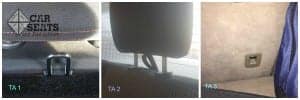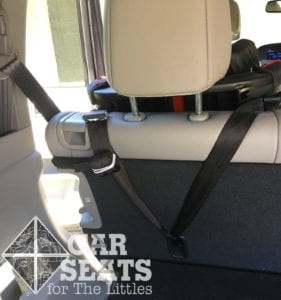Top tethers are essential safety equipment for forward facing car seats. They’re generally easy to find — they’re connected at the back to the top of your child’s convertible, multimode, or combination car seat.
There are two parts to top tether togetherness. The top tether anchor on the car seat and the tether anchor on the vehicle itself.
Tether anchors are the second part of this critical car seat equipment! They’re not always so easy to find, and thankfully for that situation we have the vehicle’s manual.

Tether anchor locations 1. Dash Behind Head Restraint
2. Fabric Loop Tether Anchor in Truck
3. Center Back of a Bench Seat
Most tether anchors are fairly easy to locate and use. But like many things in vehicle design, not all tether anchors are created equal.
Finding and using some tether anchors requires a little more time and love than others. We’re here to offer you some advanced tether tips from our staff of busy CPSTs.
Twist the Hook (not the Tether)!
Tether anchors are sometimes recessed in the back of a vehicle seat and surrounded by hard plastic. If the anchor itself is located awkwardly within this hard plastic, hooking the top tether onto the anchor can be a challenge — or even seem impossible at first!
When CPSTs encounter these difficulties, the first trick we try is to rotate the hook of tether a bit. By hooking at an angle and then placing the tether in its proper orientation, we can nearly always finesse a tether into its proper location.
Attach the Tether First

This truck anchor is behind the seat: you must attach the tether first, replace the seat and continue with the installation.
To install a forward facing car seat, the first step is usually to attach and tighten the seat belt or lower anchor straps. The tether is usually the second step, only attached and tightened after the seat is properly installed with less than one inch of movement when checked properly at the belt path.But some tether anchors are so hidden that once you have the seat properly installed you can’t get to the tether to attach it.
Ask us how we know this.
For example: many trucks have tether anchors hidden behind the back seat: to install seats in these trucks you need to attach the loosened tether first, replace the seat back, and proceed to install the seat with the seat belt or lower anchors. Once the child restraint is properly tightened, tighten the tether and stow the excess webbing.
This trick can also help in some sedans with tether anchors that are very close to the seat. Some cars have a geometry that makes hooking the tether after the seat is installed nearly impossible because there’s no longer room to fit your arms in. Attaching the tether before installing can sometimes help navigate a very tight spot.
Removing a Stuck Tether while Uninstalling
Sometimes the hardest part of using a car seat is taking it out. If a pesky forward facing car seat doesn’t want to come out, first detach the seat belt or lower anchors. Then, try this essential tip for tricky tethers that are trying their best to become a permanent feature of your car. Lengthen the tether before attempting to unhook it from the vehicle.
If you’re having trouble adjusting the tether’s length, try lifting the unbuckled car seat just a bit — sometimes this takes two people — to get some slack into the mechanism so that you can lengthen the webbing.
Sometimes extending the car seat’s recline angle or front to back position of the car’s seat can create that little bit of slack that will let you get the tether lengthened and, ideally, removed.
Beware the Cargo Hook!
Not all tether anchors sport clear labels, and not all vehicle manuals are as clear as we’d like, either. Attaching that top tether on the proper anchor for the vehicle seating location you’re using is essential.

Beware! This cargo tie down is NOT a tether anchor. The tether anchor for this car is on the ceiling.
Some cars have cargo tie downs that like to masquerade as tether locations: beware the tricky cargo hook!
Cargo hooks are not tether anchors. Cargo hooks are not subject to the same standards as tether anchors and they can’t do a tether anchor’s essential job of reducing head excursion during a crash.
So take your time in any new car: read the vehicle manual, look for the child restraint logo, and if you’re having trouble, talk to a CPST to help find your tether anchors before using a forward facing seat.
Last Resort: Twist the Top Tether
In some vehicles the tether only fits when adding an 180 degree twist. This setup is not terribly common, and should only be done once all other avenues are exhausted. If you’ve come to the point where you think your tether needs a twist, confirm that both the vehicle manufacturer and the car seat manufacturer approve of twisting the tether. As always, we recommend meeting in person with a CPST for assistance.
V-shaped Tethers and Split Vehicle Seats
Tethers come in different designs: some are fixed to the convertible or combination seat in one place at the top, and some are fixed on either side. These V shaped tethers can sometimes not play well with captain’s chairs and split seat backs.
To do its job, the top tether needs to be against the vehicle seat back: it can’t fall off the shoulders of the seat.
If you have a car seat that places the tether in one of these awkward locations, first check your vehicle manual. It may address this situation or tell you to route the tether between the posts of the car’s head restraint.
Here’s another trick: try is the car seat shuffle. Can you swap that seat with another seat in a tether location and solve the problem?
If that’s not an option, some car seat manufacturers have previously approved various ways to solve the problem: contact the car seat manufacturer to see what they approve. And though it’s not a fun outcome, know that not all car seats are compatible with all locations in the car.
We hope that sharing a few tricks from the CPST’s toolbox can help you get those forward facing seats tethered for every trip! And as always, contact a CPST for help in person: we love to help.





